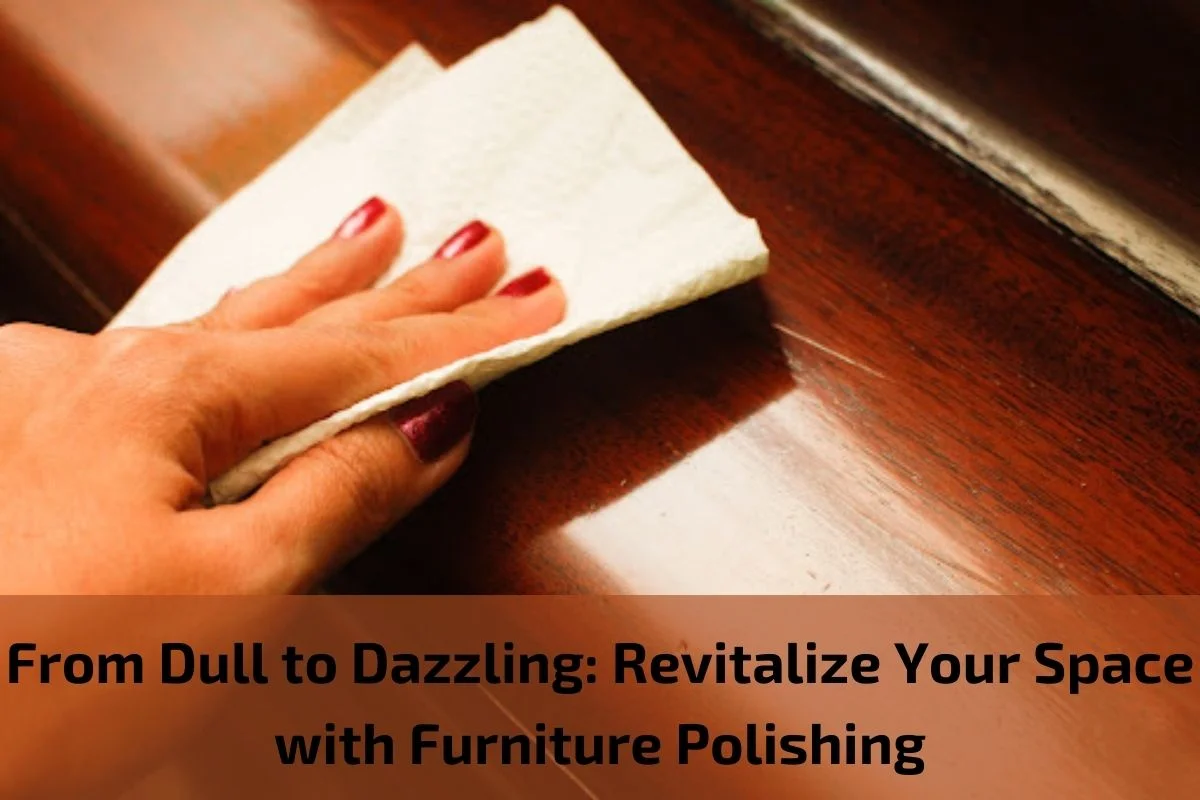In the world of interior design, where every piece plays a pivotal role in shaping the ambiance of a space, furniture stands as a silent yet impactful contributor. Over time, even the most exquisite pieces can lose their luster, succumbing to the wear and tear of daily life. But fear not, for there’s a transformative solution that can revive the brilliance of your furnishings and breathe new life into your living spaces – the art of furniture polishing.
In our journey from “Dull to Dazzling,” we explore the timeless practice of furniture polishing and how it can serve as the secret ingredient to elevate the aesthetics of your home. Beyond the mere act of cleaning, furniture polishing is a craft that unlocks the hidden beauty of your tables, chairs, cabinets, and more, restoring their natural radiance and making them worthy focal points in your décor.
Brief overview of the importance of furniture in home décor
Furniture serves as the backbone of home decor, playing a pivotal role in shaping the aesthetic, functionality, and ambiance of a living space. Beyond mere utilitarian purposes, furniture contributes to the overall design narrative, creating a visual language that reflects the homeowner’s style, personality, and preferences.
Aesthetic Appeal:
- Furniture serves as a focal point, establishing the visual theme of a room. Whether it’s the sleek lines of modern furniture or the ornate details of antique pieces, each item contributes to the overall aesthetic appeal.
Functional Design:
- Practicality and functionality are inherent aspects of furniture design. Each piece is carefully crafted to fulfill specific needs, providing comfort, storage, and support in various areas of the home.
Spatial Arrangement:
- Furniture helps define and organize spaces within a home. The arrangement of sofas, tables, and chairs influences the flow of movement and interaction, creating a harmonious balance within the room.
Personalization and Expression:
- The selection of furniture allows homeowners to express their individuality. From the choice of materials to the style and color palette, each piece contributes to a personalized narrative, making a house truly feel like a home.
Comfort and Relaxation:
- Furniture transforms living spaces into havens of comfort. Sofas, beds, and chairs provide areas for relaxation, socializing, and rest, enhancing the quality of life for those who inhabit the space.
Cultural and Historical Significance:
- Certain furniture styles and pieces carry cultural and historical significance. Whether it’s a vintage dresser passed down through generations or a contemporary design inspired by cultural influences, furniture can be a reflection of heritage and history.
Versatility in Design:
- Furniture comes in a myriad of styles, sizes, and functionalities, catering to diverse tastes and requirements. This versatility allows homeowners to curate spaces that align with their lifestyle, whether it be minimalist, eclectic, traditional, or contemporary.
Room Transformation:
- The strategic placement and selection of furniture can dramatically transform the perception of a room. Well-chosen pieces can make small spaces appear larger, create cozy nooks, or define specific areas for various activities.
Benefits of Furniture Polishing
Furniture polishing offers a range of benefits that extend beyond mere aesthetics, contributing to the longevity, upkeep, and overall appeal of your furniture. Here are some key advantages of regular furniture polishing:
Enhanced Aesthetics:
- Restored Shine: Polishing brings out the natural luster of wood, metal, or other materials, restoring the furniture’s original shine and visual appeal.
- Revitalized Finishes: The process helps to revive and enhance the appearance of finishes, ensuring that your furniture looks as good as new.
Protection Against Wear and Tear:
- Surface Preservation: Polishing forms a protective layer on the furniture surface, guarding against scratches, stains, and general wear and tear.
- Prevention of Damage: Regular polishing helps to prevent moisture damage, reducing the risk of wood swelling or warping.
Increased Longevity:
- Preservation of Materials: By protecting the furniture surface, polishing contributes to the preservation of materials, extending the lifespan of your furniture.
- Prevention of Decay: Polishing helps deter the decay of certain materials, particularly wood, ensuring that your furniture maintains its structural integrity over time.
Healthier Indoor Environment:
- Dust and Allergen Removal: Polishing aids in the removal of dust, allergens, and particles that may accumulate on furniture surfaces, promoting a cleaner and healthier indoor environment.
- Improved Air Quality: Regular furniture maintenance contributes to better air quality by reducing the presence of airborne particles that can affect respiratory health.
Maintenance of Value:
- Preservation of Investment: Polishing is an investment in the preservation of your furniture, maintaining its value over time.
- Enhanced Resale Potential: Well-maintained and polished furniture has higher resale potential, should you ever choose to part with or upgrade your pieces.
Customary Care:
- Routine Inspection: Polishing allows for routine inspection of furniture, helping identify and address any issues such as loose joints or hardware, ensuring the furniture remains in optimal condition.
- Preventive Maintenance: By making polishing a regular part of your furniture care routine, you engage in preventive maintenance, addressing potential problems before they escalate.
Personal Satisfaction:
- Aesthetic Enjoyment: Well-polished furniture contributes to a visually pleasing and cohesive living space, enhancing your overall satisfaction with your home.
- Sense of Accomplishment: The act of polishing and witnessing the transformation of your furniture provides a sense of accomplishment and pride in maintaining your living space.
Sustainable Practices:
- Environmental Impact: Proper furniture maintenance, including polishing, supports sustainability by extending the life cycle of furniture, reducing the need for frequent replacements.
- Reduced Waste: Regular care and maintenance contribute to a reduction in furniture waste, aligning with eco-friendly practices.
Choosing the Right Polish for Different Furniture Finishes
Choosing the right polish for different furniture finishes is essential to ensure effective cleaning, protection, and enhancement of the specific materials used in your furniture. Here’s a guide to help you make informed decisions based on various furniture finishes:
Wooden Furniture:
- For Varnished or Lacquered Wood: Choose a polish specifically formulated for varnished or lacquered wood. These polishes often contain conditioning agents to prevent drying and cracking.
- For Unfinished Wood: Beeswax-based polishes work well on unfinished wood, providing a protective layer and enhancing the natural beauty of the grain.
- Antique Wood: Consider a wax-based polish suitable for antique wood. It provides a gentle, nourishing touch without compromising the patina.
Metal Furniture:
- Stainless Steel: Opt for a stainless steel cleaner and polish to remove fingerprints, smudges, and watermarks while adding a protective layer to resist future stains.
- Chrome or Brass: Use a metal polish specifically designed for chrome or brass surfaces. These polishes typically remove tarnish and restore shine without scratching.
Painted Furniture:
- General Cleaning: For everyday cleaning of painted surfaces, a mild, water-based furniture polish or a mixture of mild detergent and water on a soft cloth is suitable.
- High Gloss Finishes: Use a polish specifically designed for high-gloss finishes to maintain the glossy appearance without causing damage.
Leather Furniture:
- For Aniline Leather: Aniline leather is best treated with a mild, water-based leather cleaner and conditioner to retain its natural appearance.
- Protected or Pigmented Leather: Choose a polish designed for protected or pigmented leather. These polishes often contain moisturizing agents to prevent drying and cracking.
Glass or Mirror Furniture:
- Glass Cleaner: Use a glass cleaner for glass or mirror surfaces to remove fingerprints, smudges, and streaks.
- Avoid Wax-Based Polishes: Avoid wax-based polishes on glass, as they can leave a residue that is challenging to remove.
Veneer Furniture:
- Gentle Formulas: Opt for a gentle furniture polish suitable for veneer surfaces. Avoid abrasive polishes that may damage the thin layer of veneer.
- Avoid Silicone-Based Polishes: Silicone-based polishes may leave a residue that attracts dust, potentially causing build-up on veneer surfaces.
Stone or Marble Furniture:
- Neutral pH Cleaner: Use a neutral pH stone or marble cleaner to avoid damaging the surface. Acidic or abrasive cleaners can harm the natural beauty of these materials.
- Avoid Wax or Oil-Based Polishes: Stone and marble surfaces typically do not require traditional polishes. Instead, focus on regular cleaning to maintain their appearance.
Outdoor Furniture:
- Weather-Resistant Polishes: If your furniture is exposed to the elements, choose polishes specifically designed for outdoor use. These often provide extra protection against UV rays, moisture, and other environmental factors
Step-by-Step Guide to Furniture Polishing Techniques
Achieving a polished and gleaming finish on your furniture involves a systematic approach. Here is a step-by-step guide to effective furniture polishing techniques:
Gather Your Supplies:
Collect the necessary supplies, including furniture polish suitable for your specific furniture finish, soft lint-free cloths, and any additional tools recommended by the polish manufacturer.
Dust Removal:
Begin by dusting the furniture thoroughly. Use a soft, dry cloth or a feather duster to remove loose particles, ensuring a clean surface for the polishing process.
Surface Cleaning:
For surfaces with built-up grime or stains, clean the furniture with a mild, soapy solution or a dedicated furniture cleaner. Wipe down the surface with a damp cloth and allow it to dry completely.
Spot Test:
Before applying the furniture polish, conduct a spot test on an inconspicuous area to ensure compatibility and to check for any adverse reactions.
Polish Application:
Apply a small amount of furniture polish onto a soft, clean cloth. Avoid applying the polish directly to the furniture surface to prevent over-application.
Circular Motion:
Using a circular motion, gently rub the polish onto the furniture surface. This technique helps distribute the polish evenly and promotes absorption into the material.
Work in Sections:
Divide larger furniture pieces into manageable sections. Work on one section at a time to ensure thorough coverage and prevent the polish from drying prematurely.
Focus on Details:
Pay special attention to intricate details, carvings, or any areas that may be more challenging to reach. Use a smaller cloth or specialized tools for intricate designs.
Buffing:
Allow the polish to sit for the recommended time specified by the product instructions. Once the polish has set, use a clean, dry cloth to buff the furniture surface. Buffing not only enhances the shine but also removes excess polish.
Repeat if Necessary:
If the desired level of shine is not achieved after the first application, repeat the process. Be cautious not to overuse the polish, as this can lead to residue build-up.
Final Inspection:
Inspect the entire furniture piece to ensure an even and polished finish. Address any spots or streaks by applying additional polish as needed.
Protective Measures:
Consider applying a furniture wax or protective spray, especially for wood furniture, to add an extra layer of protection and maintain the polished finish for an extended period.
Regular Maintenance:
To keep your furniture looking its best, establish a regular maintenance routine. Dust regularly and use a slightly damp cloth for general cleaning between polishing sessions.
Mindful Placement:
Be cautious when placing items on freshly polished furniture to avoid leaving imprints or scratches. Allow the polish to fully cure before heavy use.
The Role of Furniture Polishing in Maintenance
Furniture polishing plays a crucial role in the ongoing maintenance of your furniture, offering both aesthetic and functional benefits that contribute to the longevity and overall well-being of your pieces. Here’s a detailed exploration of the pivotal role furniture polishing plays in maintenance:
Surface Protection:
Preventing Wear and Tear: Furniture polishing creates a protective layer on the surface, guarding against scratches, stains, and general wear and tear. This barrier helps maintain the integrity of the material, extending the life of the furniture.
Moisture Resistance:
Avoiding Water Damage: Polishing provides a degree of moisture resistance, preventing water or liquid damage that could lead to swelling, warping, or discoloration of wooden surfaces.
UV Ray Protection:
Shielding Against Sunlight: Continuous exposure to sunlight can fade and damage furniture finishes. Furniture polish often includes UV inhibitors, which help protect against the harmful effects of sunlight, preserving the color and vibrancy of the furniture.
Preventing Drying and Cracking:
Maintaining Wood Integrity: For wooden furniture, polishing prevents the wood from drying out and cracking over time. The conditioning agents in furniture polish nourish the wood, keeping it supple and resilient.
Restoration of Luster:
Reviving the Shine: Regular polishing is instrumental in restoring and enhancing the natural shine of furniture surfaces. It breathes new life into dull or worn-out finishes, ensuring that your furniture continues to radiate its original beauty.
Dust and Allergen Removal:
Promoting a Cleaner Environment: Polishing aids in the removal of dust, allergens, and particles that may settle on furniture surfaces. This not only contributes to a cleaner home environment but also benefits individuals with allergies or respiratory sensitivities.
Preventing Corrosion on Metal Furniture:
Metal Maintenance: For metal furniture, polishing helps prevent corrosion and rust formation. The protective layer provided by polishing guards against the damaging effects of moisture and oxidation.
Maintaining Leather Suppleness:
Leather Care: For leather furniture, polishing contributes to the maintenance of suppleness and prevents the leather from becoming brittle. This is particularly important in preserving the comfort and appearance of leather upholstery.
Regular Inspection Opportunities:
Identifying Issues Early: The act of polishing often involves a close inspection of the furniture. This provides an opportunity to identify and address issues such as loose joints, worn-out finishes, or other potential maintenance needs at an early stage.
Preserving Investment Value:
Long-Term Value: Proper furniture maintenance, including regular polishing, is an investment in preserving the value of your furniture. Well-maintained pieces often have higher resale or appraisal values.
Enhancing Aesthetic Enjoyment:
Visual Appeal: Beyond maintenance, furniture polishing contributes to the overall aesthetic enjoyment of your living space. The enhanced shine and well-preserved finishes create an inviting and visually pleasing environment.
Cultural and Sentimental Preservation:
Preserving Heritage: For antique or culturally significant furniture, polishing plays a crucial role in preserving the heritage and historical value of these pieces, ensuring they can be enjoyed by future generations.
Conclusion
In conclusion, the art of furniture polishing is far more than a routine chore; it is a commitment to the long-lasting beauty, functionality, and preservation of your cherished pieces.







